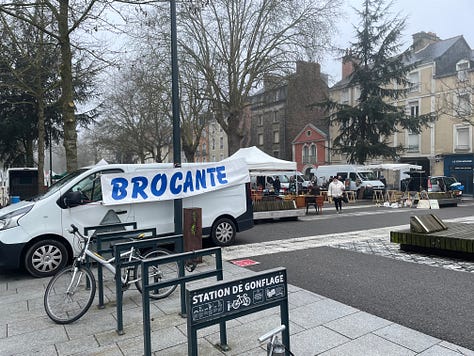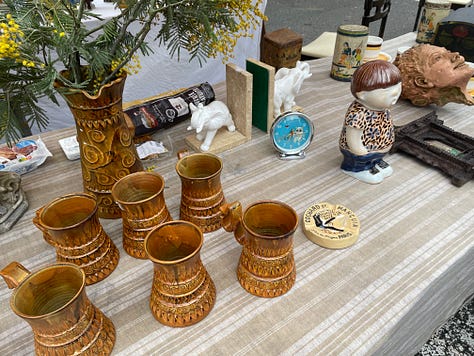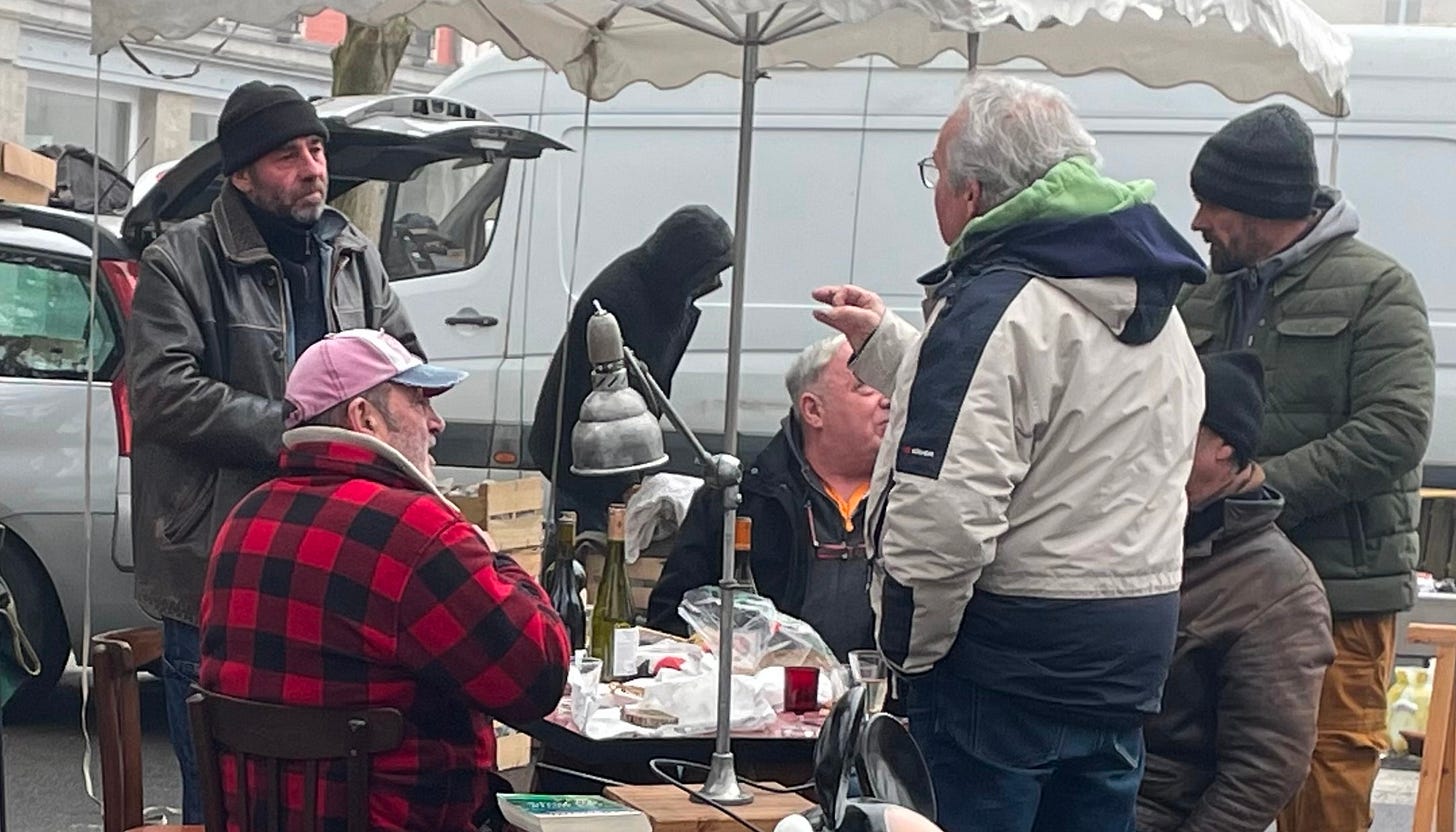Friperies, Brocantes et Les Marchés aux Puce
France loves a good deal at a second-hand market
My mother never wanted me to borrow books from the library because they were dirty and could have bugs. You can imagine how she would feel about me buying used clothes and household items.
I have to admit that a part of myself – a piece of stubborn genetic material installed by my mom – skeeves the idea of wearing clothes that have been worn by someone I’m not related to. I’m trying to get past this because I live in a city with a profusion of used and vintage clothing stores that look pretty cool. I found at least 23 permanent locations, and I don’t think that includes the new place down the street: a bar that also sells previously-owned clothes and handbags.
That’s one vintage clothing store for every 10,000 people. Never mind all the pop-up flea markets and the huge, citywide braderie held every year. The yearly sales are such a big deal that they draw merchants and customers from throughout the region. In June, during our city’s 53rd grand flea market, the streets filled up with 300,000 shoppers. The French city of Lille is host to the oldest and largest flea market in Europe, with over 10,000 vendors and a million visitors.



The variety of outlets for used clothes and home goods, combined with the language nerdery of the French, is reflected in the number of vocabulary words they have created to describe these offerings. Brocantes and Marchés aux Puces are second-hand/antique shops or flea (puce) markets. A braderie is a large street market, and its close relative, the vide grenier, is a garage sale. (Literally, an empty attic sale.) There’s also the friperie, or, une frip for short, the classic thrift store. Because English is (sometimes) considered cool here, some stores identify as “second-hand” purveyors.
The French are serious about recycling, repairing and never throwing anything away that could be repurposed or reanimated. Our neighborhood even has a monthly “Repair Cafe,” where you can bring broken appliances, toys, bikes and damaged clothes to a team of volunteers who will try to repair them. Their credo tells you a lot about the French mentality:
“This makes it possible to restore its youth to a device or any other object that has already been used a lot, and to be able to reuse it. Because the idea is not to throw away. A small weld, a resistance to change, a drop of glue, dusting . . . The repair volunteers make a diagnosis and explain to you what is wrong . . . and if they can fix it!”
People dragging shopping carts clog the streets during the outdoor sales. I am always astonished by what people will try to sell–and what others are willing to buy: dozens of barrettes and plastic sunglasses, old toys, really bad art, bags of tiny wood pellets, chipped coffee cups, shoes and used children’s underwear.
So far I have successfully avoided anything that would have grossed out my mother. What tempts me to violate her sensibilities is the quality of some of the vintage clothes at French sales. While you’re more likely to spy a Chanel jacket at an upscale vintage store in Paris, digging deep at the Rennes shops may also produce a sweet payoff, like a pair of vintage boots or a dazzling wool coat. (As the daughter of a podiatrist who made me wear flip flops even in our home shower, I intend to honor her memory by never–ever–buying used shoes.) I am, however, on the lookout for a fringed suede jacket, like the cool kids wore in the ‘70s.
And these are not just occasional events. Every day in front of the church in a nearby neighborhood filled with ancient half-timbered houses, vendors set up an outdoor book market. I’ve never been able to pass by without browsing. There are art books, novels, vintage magazine ads, and, sometimes, local artisans will join to sell paintings and handmade postcards.



On the second Sunday each month, a portion of the wide promenade in our own neighborhood comes alive with a brocante. Vendors sell books, art, jewelry, toys, clothing, lighting fixtures, vintage signs, furniture and home decor. One guy even specializes in drawings, photos and dolls of women with impressive bosoms.
The best part of our local sale is witnessing the camaraderie among the vendors as they sit around folding tables devouring cheese, bread, meat and wine. At 9 a.m. They appear all-consumed in lively conversation, until you pause at one of their tables and they quickly saunter over to hype the item you are inspecting and suggest that they may be open to letting it go for a bit less if you really like it.
We have negotiated a few sweet deals here: a cool metal desk, turquoise ring, Limoges porcelain trinket dish, side table with a magazine rack and a second magazine rack. (I should note that we do not own any magazines.)
Since our apartment has been completely furnished and we have vowed to eliminate clutter from our lives, I haven’t bought much at all at any flea or antiques market. But if that suede jacket with the long hippie fringe ever shows up, I’ll make room for it in my closet.






Another terrific post, Theresa. My mother feared germs, too, but my father was on the local library board, so a prohibition against library books never arose in my home.
When I have traveled to Europe, I have often devoted a day or two to flea markets and the like--London, Amsterdam, Paris. Yet, it was during college that I really began my devotion to vintage clothing. I bought tons of outfits from the 1940s and 1950s from Opportunity Christ Shop in Georgetown (alas they no longer sell clothing--maybe your mother got to them, Theresa!). In fact, I wore what I call my Jackie O suit to an event I hosted the other day. I had several wonderful suits from the 40s--and a great linen skirt with two kick pleats in the back (went to mid calf). And the books! I lucked out more than a few times in that realm I too hope you find your fringe jacket!
Love reading your blogs. I love a French market but keep getting warned by hubby that we only live on a 10 metre boat so not to bring home any more ‘tat’ 🤣